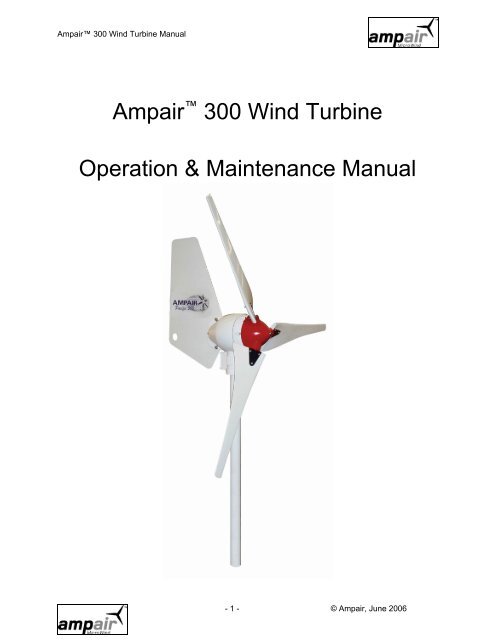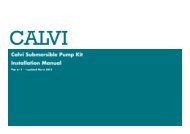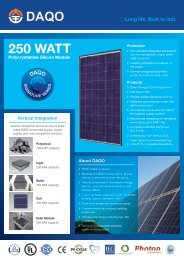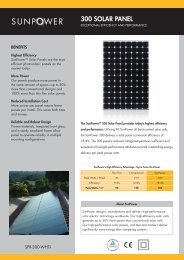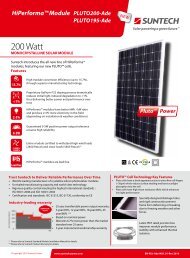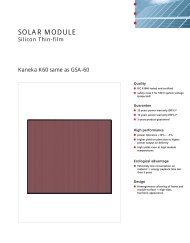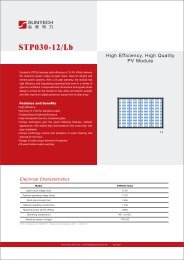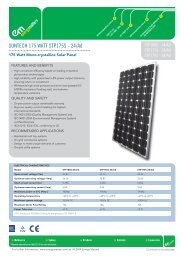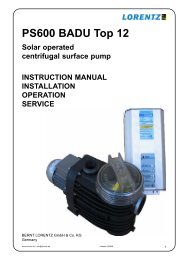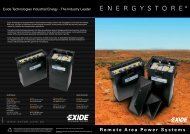Ampair Pacific 300 Wind Turbine Manual - Energy Connect UK
Ampair Pacific 300 Wind Turbine Manual - Energy Connect UK
Ampair Pacific 300 Wind Turbine Manual - Energy Connect UK
You also want an ePaper? Increase the reach of your titles
YUMPU automatically turns print PDFs into web optimized ePapers that Google loves.
<strong>Ampair</strong> <strong>300</strong> <strong>Wind</strong> <strong>Turbine</strong> <strong>Manual</strong>4.3 Accessories packing lists4.3.1 Basic <strong>Pacific</strong> <strong>300</strong> stern mount kit (SMK)The basic <strong>Ampair</strong> <strong>Pacific</strong> <strong>300</strong> Stern Mount Kit (SMK) carton contains:A 1 pcs Pole A, 800mm, Four 6.5mm holes each end, two 10.2mmholes centrallyB 1 pcs Pole B, 800mm, Four 6.5mm holes each end.C 1 pcs Pole C, 970mm, 25mm OD, strut pole,D 2 pcs Stay wires Terminated by thimbles and "D" ring nuts.E 1 pcs Bag 1 Containing: yoke, two angle feet andbackstay clamp shell.F 1 pcs Bag 2 Containing: one anodised aluminium alloyjoiner tubes.G 1 pcs Kit 1: Strut, yoke & feet fixings 1 pcs M6 x 40mm screw2 pcs M6 x 35 hex screw3 pcs M6 shakeproof washers3 pcs M6 Nyloc nuts1 pcs M10 threaded rod 75mm2 pcs M10 shakeproof washers1 pcs M8 x 60mm hex bolt2 pcs M8 plain washers1 pcs M8 Nyloc nutH 1 pcs Kit 2: Joiner tube fixings 16 pcs M6 x 10mm screws16 pcs M6 shakeproof washersThis arrangement, places the blade tips 2 metres (7 feet) above the base fixing. If there is a raised areaadjacent upon which people may stand, raise this base accordingly.4.3.2 <strong>Pacific</strong> <strong>300</strong> mizzen bracketThe <strong>Ampair</strong> <strong>Pacific</strong> <strong>300</strong> Mizzen Bracket carton contains:O 1 pcs BracketP 2 pcs threaded rod Ml0 x 150mm threaded rodQ 8 pcs Nuts MI0 nutsR 8 pcs plain washers Ml0 plain washers4 pcs Shakeproof washers MI0 shakeproof washers4.3.3 <strong>Pacific</strong> <strong>300</strong> gantry mountThe <strong>Ampair</strong> <strong>Pacific</strong> <strong>300</strong> Gantry Mount carton contains:O 1 pcs Bracket Pole with double welded base flange4.3.4 <strong>Pacific</strong> 100 to <strong>Pacific</strong> <strong>300</strong> mounting adaptorThe <strong>Ampair</strong> <strong>Pacific</strong> 100 to <strong>Pacific</strong> <strong>300</strong> mounting adaptor bag contains:O 1 pcs Adaptor tube Pole with female to male cross-over- 12 - © <strong>Ampair</strong>, June 2006
<strong>Ampair</strong> <strong>300</strong> <strong>Wind</strong> <strong>Turbine</strong> <strong>Manual</strong>4.3.5 <strong>Pacific</strong> <strong>300</strong> land mounting systemsMounting systems are available for land use of the <strong>Ampair</strong> <strong>Pacific</strong> <strong>300</strong>, but most users choose to fabricatetheir own from local materials. See guidance notes further on, or ask <strong>Ampair</strong> if you wish to purchase asystem suitable for your site.4.3.6 <strong>Pacific</strong> <strong>300</strong> basic regulatorThe <strong>Ampair</strong> <strong>Pacific</strong> <strong>300</strong> Basic Regulator comes in two versions: the 12 volt or the 24 volt version. It is notpossible to convert these from one to the other. The carton contains:A 1 pcs Regulator 12 volt or 24 volt versionB 1 pcs Operation manual4.3.7 <strong>Pacific</strong> <strong>300</strong> advanced regulatorThe <strong>Ampair</strong> <strong>Pacific</strong> <strong>300</strong> Advanced Regulator comes in only one version which can be configured for either12 volt or 24 volt use (by <strong>Ampair</strong> authorised dealers). The carton contains:A 1 pcs Regulator ConfigurableB 1 pcs Operation manual4.3.8 <strong>Pacific</strong> <strong>300</strong> stop (parking) switchThe <strong>Ampair</strong> <strong>Pacific</strong> <strong>300</strong> Stop Switch carton contains:A 1 pcs Stop (parking) switchB 1 pcs Operation manual4.3.9 Fuse holder and fusesThe bag of fuse holders and fuses contains:A 1 pcs Fuse holder For 30 Amp, slow blowB 1 pcs Fuse 30 Amp, slow blow4.4 ToolsFor installation of your <strong>Ampair</strong> <strong>Pacific</strong> <strong>300</strong> the necessary Allen keys are supplied. In addition to anyspecialist tools required for locally fabricated mounting systems, the following general tools will also behelpful:Screw driversSpannersWire strippersWire crimpersHeat shrink and/or electrical tapeMultimeter4.5 Choosing a mountingWhere and how to mount a wind turbine is critical. The consequences of selecting a poor location can beunsafe operation, poor reliability, and low power output – or all three. As well as reading these guidancenotes, if in doubt please consult <strong>Ampair</strong> or your distributor for advice.4.5.1 Siting land based unitsThe wind turbine should be sited as high as practicable, clear of windbreaks or buildings and away fromsources of turbulence. These conditions are shown diagrammatically below.- 13 - © <strong>Ampair</strong>, June 2006
<strong>Ampair</strong> <strong>300</strong> <strong>Wind</strong> <strong>Turbine</strong> <strong>Manual</strong>The top fixing point for the guys should allow for minimum overhang of the wind turbine generator, i.e. beonly a short distance below the wind turbine blade tips. This prevents the top section of the mast fromswaying too much.Tensioners: These are the simple and easiest method of tensioning guys, but adjustment must beuniform, since it is the guys that resist the thrust of the wind turbine. Do not over tension – a guy should besnugly taut, but not drum tight.Ground anchors: These should be suitable eyebolts fixedin the ground and in line with the guys. Anchors in soft earth mayrequire concrete blocks or ‘dead men’. Gravel or clay soils require“auger” type anchors (see inset picture) and rocky ground mayneed drilling and expanding rock anchors. Only the eye should bevisible above ground. Avoid waterlogged soils which have poorholding properties. Install anchor below the frost level orotherwise ‘frost heave’ will eject them.Base: This is to carry the weight of the generator and mastonly. Fixing again depends on the ground state but metal pegsdriven into soil are often sufficient. A lattice tower would need aconcrete base with expansion bolt fixings (‘rawlbolts’). It is oftenconvenient to make a pivot arrangement for the base in-line withone guy anchor to aid raising and lowering.Lightning: Directly earth all metalwork. Bury output cables (minimum ½ metre depth) between mastand battery position for better protection than suspending in air. Either run cabling through plastic conduitor use a type specified for burying by local building or electrical codes.4.5.3 Siting boat based unitsThere are four basic alternatives in the confined quarters of most small boats:a) On a tall stayed pole on the stern of a boat (either the basic or the de luxe stern mount kit).b) On a bracket on the mizzen mast of a yacht (mizzen bracket).c) On a custom made welded ‘pushpit’ structure, "A" frame, davit gantry etc. (gantry mount).d) At the main or mizzen masthead of a yacht.On a small boat space is at a premium and so the aim should be to get the wind turbine high up, awayfrom people on the busy deck. This has the advantage of placing the turbine up where the wind isstronger, but has the disadvantage of adding top weight. Mast tops are generally the most congestedlocation on a boat and so these are seldom utilised as a mounting location, irrespective of top weightconsiderations. On ketches (other than junk rigged ones) the mizzen mast provides a good location, butfor sloops stern pole mounts or stern gantry mounts are more typical compromises. The advantage of astern pole is that it can be de-rigged fairly easy (e.g. to put a boat into racing trim for a season) whereasgantries are for committed cruisers and will also typically be designed as tender davits, aerial mounts, andsolar panel mounts.- 15 - © <strong>Ampair</strong>, June 2006
<strong>Ampair</strong> <strong>300</strong> <strong>Wind</strong> <strong>Turbine</strong> <strong>Manual</strong>Very careful attention must be given to the strength and integrity of the mounting. This should be capableof withstanding a peak horizontal load of 140 kg (<strong>300</strong> lbs). Bear in mind that the blades will flex slightly inextreme weather conditions and so sufficient clearance must be left for this. The mounting should not reston a resonant surface such as the centre of a cabin roof since this may transmit any vibration making themachine audible inside.WARNING:The mounting pole should be vertical.The space between the blade tips and the mounting pole must be left clear, i.e. noclamps or other items should diminish this clearance.The pole base should be mounted where the structure is very rigid4.5.4 Mechanical installation of <strong>Pacific</strong> <strong>300</strong> stern mount kita) Check. Ensure that a complete and undamaged set of parts has been received.b) Pole position. The pole base fixing may be moved to one side provided that, when viewed from above,the angle between the strut and either wire is greater than 45 degrees.c) Pole assembly. Using the joiner tubes and M6 x 10mm screws and shake-proof washers, assemble thepoles so that pole A (holes in the middle) is the top pole, pole B (no holes in the middle) is the middle poleand the <strong>Ampair</strong> pole becomes the bottom pole (two holes only at one end for fixing the feet).A thread locking solution (e.g. Loctite 641) will stop screws shaking loose due to long term vibration. Itmay be easier to feed the cable through the poles as they are assembled.d) Feet. Using the M8 x 60mm bolt, washers and nut, fix the feet to the pole end and screw down the feet.The feet should be arranged so the pole can pivot in line with the strut. This usually means aligned foreand aft unless the pole is off-centre.e) Stay Wires. Having assembled the poles with joiner tubes, site the pole and attach the two stay wireswith the yoke in place on the pole. Find suitable points for the stay wire base fixings, allowing for the factthat these will be under considerable tension in use. "Bottle screws" are suggested as a tensioningmethod.f) Backstay strut. File the groove in the strut pole end and clamp shell to accommodate the backstay wirediameter less 0.5mm. Cut the strut pole to length required. Drill the hole for the strut to yoke bolt in situ toensure correct orientation of holes. Ideally the strut should form a right angle with the backstay.4.5.5 Mechanical installation of <strong>Pacific</strong> <strong>300</strong> mizzen bracketThe major load that the bracket has to withstand is one of torsion, hence the box section. At 100mm widethis is close to the width of many mizzen masts and any slight difference can be accommodated bybending the end plates to suit or by spacing with nuts and washers.Drill through the end plates and mizzen and fit using the M10 fixings provided. Monel rivets are the bestattachment method for aluminium masts. Studs are best for wooden masts. If using studs on aluminiummasts then fit spacers so as not to crush the mast.If there is any danger of running rigging becoming entangled in the wind turbine then install stays to keepthe turbine guarded.4.6 Electrical installationElectrical installation should only be performed by competent personnel who have studied this manual. Ifin doubt ask <strong>Ampair</strong>.First mechanically mount the main system components (except the wind turbine), then run the fieldcabling, then make the connections, then install the wind turbine and connect to it. Only then connect tothe battery.WARNING:Do not assemble the generator, vane and turbine until the electrical installation is- 16 - © <strong>Ampair</strong>, June 2006
<strong>Ampair</strong> <strong>300</strong> <strong>Wind</strong> <strong>Turbine</strong> <strong>Manual</strong>completed4.6.1 Wiring diagrams4.6.1.1 Wiring diagram without regulatorBlock diagramDC colour code:Red = positive (+)Black = negative (-)Fuse sizing:30 A for 12 V15 A for 24 Vammeterstopswitchrectifierfuse-battery +alternating current, ACdirect current, DC- 17 - © <strong>Ampair</strong>, June 2006
<strong>Ampair</strong> <strong>300</strong> <strong>Wind</strong> <strong>Turbine</strong> <strong>Manual</strong>4.6.1.2 Wiring diagram with regulatorBlock diagramDC colour code:Red = positive (+)Black = negative (-)Fuse sizing:30 A for 12 V15 A for 24 Vstopswitchrectifierammeter*regulatorfuse* Ideally connect the ammeter betweenthe rectifier and the regulator.-battery +<strong>Connect</strong>ion diagram(rectifier or integratedregulator + rectifier)DC colour code:Red = positive (+)Black = negative (-)Fuse sizing:30 A for 12 V15 A for 24 Vstopswitchrectifier*ammeterfuse*rectifier or integrated rectifier + regulator(such as the S-12-<strong>300</strong> and S-24-<strong>300</strong>)-battery +- 18 - © <strong>Ampair</strong>, June 2006
<strong>Ampair</strong> <strong>300</strong> <strong>Wind</strong> <strong>Turbine</strong> <strong>Manual</strong><strong>Connect</strong>ion diagram(separate regulator andrectifier)DC colour code:Red = positive (+)Black = negative (-)Fuse sizing:30 A for 12 V15A for 24 Vstopswitchrectifier /heat sinkammeterregulatorgen1+gen2+gen-bat-bat1+bat2+fuse-battery +*separate rectifier and regulator such as PR-<strong>300</strong> used in single in / single out configuration<strong>Connect</strong>ion diagram(separate regulator andrectifier)DC colour code:Red = positive (+)Black = negative (-)Fuse sizing:30 A for 12 V15A for 24 Vstopswitchrectifier /heat sinkammeterbat+in+regulatorsensesense+- fusesbattery +*separate rectifier and regulator such as NC25A used in single in / single out configurationIf the <strong>Pacific</strong> <strong>300</strong> wind turbine is connected on the load side of the battery isolator switch, it may damageelectrical equipment. Under these conditions it is possible to run the wind turbine whilst the battery isisolated, but this can subject the system to excess voltage.- 19 - © <strong>Ampair</strong>, June 2006
<strong>Ampair</strong> <strong>300</strong> <strong>Wind</strong> <strong>Turbine</strong> <strong>Manual</strong>WARNING:<strong>Connect</strong> the wind turbine to batteries, not to loads.4.7 Electrical components4.7.1 WiringAfter deciding where the wind turbine is to be mounted measure the length of the wiring that will actuallyrun to the battery in both the AC section (the three wire section from the turbine to the rectifier) and the DCsection (the two wire section from the rectifier to the battery). Then select the minimum cross sectionalarea per cable from the table below. Wherever possible locate the rectifier as close to the battery so as tominimise the DC cable length and to maximise the AC cable length.Minimum AC cable size for 12 volt wind turbine:Total AC section lengthMinimum cross sectionalarea per cableUp to 8 mUp to 27 ft2.5 mm 214 AWG8 to 12 m27 to 40 ft4 mm 212 AWG12 to 18 m40 to 60 ft6 mm 210 AWG18 to 30 m60 to 100 ft10 mm 28 AWG30 to 50 m100 to 166 ft16 mm 26 AWG30 to 76 m166 to 253 ft25 mm 24 AWG76 to 100 m253 to 333 ft35 mm 22 AWGMinimum DC cable size for 12 volt wind turbine:Total DC section lengthUp to 5 mUp to 16 ft5 to 10 m16 to 32 ft10 to 18 m32 to 60 ft18 to 28 m60 to 90 ft28 to 44 m90 to 145 ft44 to 68 m145 to 220 ft68 to 110 m220 to 360 ftMinimum cross sectionalarea per cable4 mm 212 AWG6 mm 210 AWG10 mm 28 AWG16 mm 26 AWG25 mm 24 AWG35 mm 22 AWG50 mm 21 AWGMinimum AC cable size for 24 volt wind turbine:Total AC section lengthUp to 8 mUp to 27 ft8 to 12 m27 to 40 ft12 to 18 m40 to 60 ft18 to 30 m60 to 100 ft30 to 50 m100 to 166 ft30 to 76 m166 to 253 ft76 to 100 m253 to 333 ftMinimum cross sectionalarea per cable1.5 mm 216 AWG2.5 mm 214 AWG4 mm 212 AWG6 mm 210 AWG10 mm 28 AWG16 mm 26 AWG25 mm 24 AWGMinimum DC cable size for 24 volt wind turbine:Total DC section lengthUp to 5 mUp to 16 ft5 to 10 m16 to 32 ft10 to 18 m32 to 60 ft18 to 28 m60 to 90 ft28 to 44 m90 to 145 ft44 to 68 m145 to 220 ft68 to 110 m220 to 360 ftMinimum cross sectionalarea per cable2.5 mm 214 AWG2.5 mm 214 AWG4 mm 212 AWG6 mm 210 AWG10 mm 28 AWG16 mm 26 AWG25 mm 24 AWGWARNING:Insufficient cross sectional area of conductor will cause the cable to heat up and create afire hazard all along the cable, at the same time.WARNING:Always use tinned stranded conductors for best corrosion protection on boats.WARNING:<strong>Connect</strong> with the correct polarity. When wiring the DC system be aware that if the windturbine is connected to the battery by the reverse polarity the output rectifiers may bedestroyed or the internal soldered connections to the brush holders may melt. Check anddouble-check DC polarity before final connection.BROWN or RED = + PositiveBLUE or BLACK = - Negative (YELLOW is preferred colour in the USA)- 20 - © <strong>Ampair</strong>, June 2006
<strong>Ampair</strong> <strong>300</strong> <strong>Wind</strong> <strong>Turbine</strong> <strong>Manual</strong>When mounting the <strong>Ampair</strong> <strong>Pacific</strong> <strong>300</strong> on its mounting pole or bracket, the cable needs to be fed downthrough the mounting. When arranging this cable make sure it cannot chafe at the point where it leavesthe mounting pole. Either lead the cable out of the bottom of the pole in a gentle curve or, drill an exit holein the pole large enough to take a rubber grommet to protect the cable from the sharp edges of the hole.In marine environments cables with tinned multi-strand conductors are recommended to prevent salt aircorrosion which will otherwise cause substantial performance reductions in a short time.Wiring between the generator (or junction box, connector, etc.) and the battery area should be clipped atregular intervals to the structure for safety and a neat job.On boats, to carry power from the <strong>Ampair</strong> to internal wiring we recommend that a good quality water-tightconnector be fittedCable hanging inside masts can be quite heavy. We recommend fitting a strain relief at the top so that theweight is not carried by the wind turbine. Arrange this strain relief so that if the cable is disconnected fromthe wind turbine (so as to remove the wind turbine for maintenance) then the end of the cable can besecured and not fall down inside the mast.If there is any danger of the cable ‘slatting’ noisily inside a hollow mast, then place some closed cell foampipe insulation over it as anti-slatting collars.Maintain a consistent colour scheme throughout the cable runs, and mark line ends with a positive (+) andnegative (-) symbol to minimise risk of errors. At different times and in different countries the colourschemes used in wiring systems have varied. If reusing old cable runs the only way to be sure is tocarefully trace all the cables and ‘loop test’ them yourself during initial installation,4.7.2 Fuses and circuit breakersFuses or miniature circuit breakers (MCBs) should always be fitted. The simplest possible arrangementfeeds the power from the <strong>Ampair</strong> directly to the battery via an in-line fuse in the positive line near to thebattery.WARNING: Always install a fuse. The fuse should be next to the battery terminal since, in the eventof a fault or damage to the cable, the battery will supply the fault-current.Do not place the fuse inside the battery compartment itself as, in the event of a build upof explosive hydrogen/air mixture in the battery compartment, the spark from a blowingfuse could provide the detonation source.4.7.3 Parking (stop) switch<strong>Connect</strong>ion diagram(stop switch)stopswitchWe recommend installing a ‘stop’ switch which should bemore correctly thought of as a ‘parking’ switch. Just as theparking brake in a car should not be relied on to stop a car athigh speed, so the parking switch of the <strong>Ampair</strong> wind turbineshould not be relied on to stop the rotor disc in high winds.Instead it is best to apply it before the arrival of very highwinds, or if needing to ensure that the rotor does not move inlow winds (e.g. when approaching the rotor for maintenance).The switch should be wired as shown in the diagram above.If wired in this way the wind turbine will be stopped with theswitch in the ‘ON’ or ‘1’ position, and will run normally withthe switch in the ‘OFF’ or ‘0’ position.- 21 - © <strong>Ampair</strong>, June 2006
<strong>Ampair</strong> <strong>300</strong> <strong>Wind</strong> <strong>Turbine</strong> <strong>Manual</strong>4.7.4 AmmeterWe recommend installing a basic ammeter so as to monitor the performance of the system. It should bewired in series (assuming it to be of the internal shunt variety) with one line, normally the positive. This willallow the machine output to be seen at all times. As shown, the positive (+) connection of the ammeter ismade to the generator, whilst the negative (-) is made to the battery. It is best to connect the ammeter inthe section of cable between the rectifier and the regulator as otherwise the voltage drop across theammeter prevents the regulator seeing the battery voltage. This point is particularly important if a poorquality ammeter is fitted. It does not apply if 'sense' wires are used.WARNING: Never connect an ammeter across the supply.4.7.5 RectifiersThe purpose of a rectifier is to convert the three phase alternating current (AC) of the turbine to directcurrent (DC) that is useful to the battery. The rectifier may either be incorporated within the regulator ormounted separately. The advantage of incorporating it in the regulator is that wiring is easier and it is asealed unit. The advantage of keeping them as separate components is that the regulator is more likely tofail than the rectifier, and without a rectifier the turbine is useless. So a turbine with a separate rectifier canbe manually regulated in case of a regulator failure.A separate rectifier should be mounted near the regulator and/or the battery. It should be mounted on aheat sink (supplied with <strong>Ampair</strong> rectifiers) and connected as shown in the diagram below.<strong>Connect</strong>ion diagram(rectifier only)DC colour code:Red = positive (+)Black = negative (-)Fuse rating:40 A for 12 V20A for 24 Vrectifier /heat sinkammeterfusethreephaseACDC-battery +*separate rectifier with no other components4.7.6 Regulators<strong>Ampair</strong> manufactures charge control regulators for protecting lead acid batteries from overcharge. Theyare not "shunt" type regulators, which dissipate excess charge as heat, but an electronic power switchwhich disconnects the generator from the battery at the regulation voltage. When the generator isdisconnected it will ‘freewheel’ at a faster speed.- 22 - © <strong>Ampair</strong>, June 2006
<strong>Ampair</strong> <strong>300</strong> <strong>Wind</strong> <strong>Turbine</strong> <strong>Manual</strong>Three different regulators are available for the <strong>Ampair</strong> <strong>Pacific</strong> <strong>300</strong>. The S-12-<strong>300</strong> and the S-24-<strong>300</strong> areencapsulated regulators with integral rectifiers. They only have one input channel and one output channel.The correct regulator must be purchased to suit the turbine and battery bank layout, i.e. 12 volt or 24 volt.No user configuration is possible of the S-12-<strong>300</strong> or S-24-<strong>300</strong>.The battery voltage is sensed at the regulator output connection, therefore install the regulator as near thebattery as practicable and keep the connecting cables short. The regulators charging continuously until aLo or Hi voltage is reached, depending on the battery output used. The generator is then disconnectedfrom the battery. Off-charge the battery voltage will fall. At a voltage of 0.5V below the regulation voltage a30-second time delay is activated. This delay prevents the regulator from oscillation (hunting) whencharging batteries under load.The PR-<strong>300</strong> is a user configurable regulator which must be installed with a separate external rectifier. Itcan be configured as either a 12 volt unit or a 24 volt unit by inserting the appropriate fused links. It canalso be configured to provide either two inputs (two wind turbines or a wind turbine and solar panels) ortwo outputs (two separate battery banks). The PR-<strong>300</strong> regulator voltage set point can be adjusted usinginternal links. In the PR-<strong>300</strong> fuses are used in other links to set 12/24 volt operation and to determine theinput and output channels. The PR-<strong>300</strong> has its own output fuse (i.e. no separate fuse is required in thebattery compartment). There are status lamps on the PR-<strong>300</strong>.4.7.6.1 Installation of regulatorsAt initial start-up, allow a gap of 1 minute for circuit timing functions to become active.Fuse Warning: Never omit fuses, simple in-line fuse carriers may be used, they protect your system fromexcessive battery currents in the event of a serious electrical fault. If they keep blowing, find out why.The external fuses must be near to the battery terminals since, in the event of a fault, the batteries wouldsource the fault current. Check and double-check polarities before making connections, insert the fuses inthe fuse carriers last of all.All multistage regulators are internally protected by an SAE cartridge fuse. These are not substitutes forbattery protection fuses.Corrosion: This is the enemy of all electrical connections, especially in marine environments. Siteregulators in a weather proof location, as dry as possible and splash proof. Inspect all terminations andconnections for signs of corrosion. Rectify by cleaning, remaking etc. Use tinned copper wire for extensionleads to prevent corrosion spreading inside cable insulation.Operating Problems: A digital multimeter is useful for checking operation/fault finding if no permanentmonitoring instruments are used. Battery voltage levels and those of the charging source can be readdirectly. Charging current readings will require the multimeter to be installed in line. In this way currentsinto and out of the regulator can be observed. Do not remove battery connections since regulatoroperation depends on a very small supply current. If the regulator is suspect then it can be temporarilybypassed by connecting the source positive direct to a battery positive. The negative connections arecommon and do not need disturbing unless regulator replacement is necessary. Use the multimetercontinuity range to confirm all cable runs are low resistance.Operation: When installed, the generator and regulator will run and maintain the batteries automatically.The unit may be run in conjunction with any other charge-source with no known interactive problems.Regular battery inspection and topping up must still be carried out to obtain maximum battery life.Faulty regulator ? If the regulator is suspect, then it can be temporarily bypassed i.e. connect therectified output of the <strong>Ampair</strong> directly to the battery terminals observing correct polarity. If this reinstatescorrect charging, then the regulator must be serviced or replaced. Regulators draw a small current(typically 1mA at 12V; more on the PR-<strong>300</strong> because of the status lamps) from the battery to activate thesense and control circuits. Without this connection the regulator will be inoperative.WARNING:Do not service regulators with the wind turbine running. First stop the wind turbine, thenremove wires (or fuses), then service the regulator.- 23 - © <strong>Ampair</strong>, June 2006
<strong>Ampair</strong> <strong>300</strong> <strong>Wind</strong> <strong>Turbine</strong> <strong>Manual</strong>4.7.7 BatteriesWe recommend large battery banks. A minimum <strong>300</strong> AmpHour battery bank is advisable, and 400 or 500AmpHours would be sensible.4.8 Final assemblya) Mounting the <strong>Ampair</strong>. Put a thin film of grease on the pivot shaft and its fixing screw threads to preventcorrosion. Bring the <strong>Ampair</strong> body to the mounting arrangement, pass the three core cable down themounting pole, insert the pivot shaft of the <strong>Ampair</strong> into the top and secure the fasteners. The top of thepole is made to compress the lower pivot bearing "V" seal by about 2mm - if you have made your ownfixing tube, be aware of this point to ensure free turning and weather proof sealing.b) Output Cable. Make the final electrical connections to the battery, as shown in the electrical section,Insert the fuse or fuses in their carriers.WARNING:To avoid injury, fit the tail vane first. If you fit the wind turbine first, the machine will turnout of control and be a danger to approach.c) Tail Vane. Clamp the tail vane using the M8 x 25mm screws washers and lock nuts.d) <strong>Wind</strong> turbine. Assemble the blades to the hub with the thick edge (the leading edge) facing the windusing the M5 x 40mm fasteners, shake-proof washers and nuts. Fix the blades in place and correctlyfasten the pitch weights on the rear of the blades (see picture below, taken with hub removed for clarity).The holes in the blades are a deliberately tight fit and it may be necessary to turn the fasteners as they areinserted. First loosely fit all the nylock nuts by hand, then fully tighten with a spanner. Finally, recheck thetightness of all the nuts.- 24 - © <strong>Ampair</strong>, June 2006
<strong>Ampair</strong> <strong>300</strong> <strong>Wind</strong> <strong>Turbine</strong> <strong>Manual</strong>WARNING:Put a rope over the <strong>Ampair</strong> passing through the blades to prevent its turning as you carryout the final checks. Once the mounting is complete, make sure all personnel are clear,turn the <strong>Ampair</strong> to face the wind and whilst holding the vane step back and remove therope.Check all fixings at regular intervals, especially after severe winds.5 OPERATION & PERFORMANCE5.1 Starting and stoppingStarting up. It is assumed that the wind turbine has been assembled and installed as above. If so thenremove any ropes that prevent it swivelling or the blades rotating, stand well clear, and turn the parking /stop switch to ‘OFF’ or ‘0’. Provided there is sufficient wind and the turbine has been correctly installed itwill commence turning.Stopping. The wind turbine has been designed to survive storms, however, it is a good plan to stop themachine if a hurricane is expected or to carry out inspection. Ideally stop the wind turbine using theparking / stop switch, by turning the switch to 'ON' or '1'. If one has not been fitted then proceed withcaution, approach the <strong>Ampair</strong> from downwind and grasp the tail vane (use a boathook if available). Thehole in the bottom rear of the tail fin is intended to make this easier. Carefully turn the machine off windand when the blades stop, throw a rope over them and tie down. Never throw a rope into the turningblades.WARNING:To avoid personal injury wear sturdy gloves as a precaution. The wind turbine blades arecapable of causing grave personal injury and should be treated with the same respect asan aircraft propeller.- 25 - © <strong>Ampair</strong>, June 2006
<strong>Ampair</strong> <strong>300</strong> <strong>Wind</strong> <strong>Turbine</strong> <strong>Manual</strong>5.2 PerformanceThe graph shows the output for a range of wind speeds. The drag due to the wind turbine is about 160Newtons (16 kg / 35lbs) at 20 metres per second (40 knots) wind speed.Power (Watts)350<strong>300</strong>25020015010050PowerRPMPower & Speed Curves16001200800400Speed (RPM)00 5 10 15 20<strong>Wind</strong> Speed (m sec-1)030Charging Current30Current (Amps)25201510Current (12 volts)Current (24 volts)25201510Current (Amps)5500 5 10 15 20<strong>Wind</strong> Speed (m sec-1)070Open Circuit VoltageOpen Circuit pd - Volts60504030201000 500 1000 1500 2000RPM- 26 - © <strong>Ampair</strong>, June 2006
<strong>Ampair</strong> <strong>300</strong> <strong>Wind</strong> <strong>Turbine</strong> <strong>Manual</strong>6 INSPECTION & MAINTENANCEFirst stop the machine, see section on Stopping.WARNING:The wind turbine blades are capable of causing grave personal injury and should betreated with the same respect as an aircraft propeller.Put a rope over the <strong>Ampair</strong> passing through the blades to prevent its turning as you carryout the final checks. Once the mounting is complete, make sure all personnel are clear,turn the <strong>Ampair</strong> to face the wind and whilst holding the vane step back and remove therope.Check all fixings at regular intervals, especially after severe winds.To avoid personal injury wear sturdy gloves as a precaution.Regularly inspect the following:Blade fasteners & nutsHub cap fixing (centre) screw<strong>Wind</strong> turbine bladesTail vane screwsPole mount screwsThe <strong>Ampair</strong> wind turbine generator should be inspected regularly, particularly after stormy weather, forsigns of accidental damage. Any minor nicks in the edge of a blade may be filled with epoxy, but bladesmust be replaced if there is any sign of damage or cracking near the root. All three blades undergo verysimilar stresses in service and so if one blade needs replacing then all three must be replaced.WARNING:Never allow the machine to run out of balance.The blade material has good fatigue resistance which is of the utmost importance in hostile locations suchas tropical sunshine and mountain tops. The material is, however, subject to slow degradation due to ultraviolet light which increases towards the tropics and with altitude. This process is slow and when itbecomes apparent as a slight crazing of the blade surface, particularly along leading and trailing edges.The design of the blades makes the <strong>Ampair</strong> a very quiet running machine. If vibration is encountered, thisis evidence that the turbine is running out of balance. To prevent any resultant noise and the risk of fixingsworking loose, it is most important to take action. Remove the turbine, take out the blades and examinethem. If they are unbalanced and/or damaged then replace them. If they appear fine but vibration stilloccurs then it is possible that there is internal damage or a mounting system fault.Any other machine noise should also be investigated. Only after very extended running life should therebe any detectable bearing noise. If this is the case, refer to the maintenance section for instructions ontheir replacement.The lower pivot bearing and "O" seal should be renewed after 2 - 3 years of regular use. The bearingsshould be replaced when they become noisy. Regularly check the security of the fixings on hub, vane andpole. If damage to the paint occurs, clean off any corrosion and repaint. Clean the brushes, taking care notto damage the brush springs when handling.6.1 Major disassemblya) Stop the wind turbine rotating.b) Disconnect from the batteries, removing the fuses first.- 27 - © <strong>Ampair</strong>, June 2006
<strong>Ampair</strong> <strong>300</strong> <strong>Wind</strong> <strong>Turbine</strong> <strong>Manual</strong>c) Remove the wind turbine’s hub and blades. The hub centre cap screw has a conventional right handedthread. A smart tap on an Allen key (hex wrench) may be necessary to disengage it from the freewheelingalternator. Pull the hub away from the machine. Depending on circumstances it may be easier to take theblades off individually and then the hub.d) Remove the tail vane.e) Feed some excess cable length up the pole.f) Remove the fasteners from the pivot and lift the machine off the pole.6.1.1.1 Hub sectionThe hub (the nose cone) which contains the PowerFurl furling mechanism is not a user serviceablecomponent and a sealed replacement unit should be installed.If it is necessary for a user to dismantle the hub in an emergency then great care should be taken to keepthe assembly clean and dust free. If dismantling the hub little or no lubrication is required – just a very lightsmear of chain oil on the slider and crank pins. No special tools are required for hub disassembly otherthan circlip pliers and parallel sided punches, but a decent workbench with a vice and some wood blockswill be useful.6.1.1.2 Pivot sectionWith the machine on the bench, undo the electrical box cover and disengage the three brushes andremove the brushes to a safe place. Prise out the end of the spiral retaining ring from around the pivotlower bearing. Withdraw the pivot assembly; a good tug may be needed. Inspect the slip rings, clean ifnecessary. Badly corroded/pitted slip rings should be lightly skimmed on a lathe.Inspect the lower bearing, if this is loose, obtain a replacement. Inspect the top bearing in the pivothousing. Inspect the "O" rings and "V" seal, replace if worn. It is sometimes easier to remove the <strong>Ampair</strong>generator head with the pivot in situ. Disconnect the battery first and remove the brushes. Uncoil theretaining ring and lift the body over the pivot. The exposed slip-ring must be protected from theenvironment if the generator is removed for further servicing.When reassembling put silicone grease (not petroleum grease or jelly) around the shaft where it passesthrough the lower bearing. Slide the bearing and "V" seal down the shaft about 20mm and wipe greasearound the shaft. Slide the bearing back up the shaft and remove the excess grease, wipe a fillet ofgrease around the point where the "V" seal sits and slide the "V" seal into place. Before reinsertion wipethe slip rings to remove any trace of contamination due to handling and put grease around the lowerbearing "O" ring. Gently slide into place and wind the spiral retaining ring into its grove. Clean and replacethe brushes (spare brushes are available but brushes have a very long life due to the low rotationalspeeds). Re-check the pivot for excess side play, if this is suspect replace the lower bearing and "O" ring.Failure to do so may wear the pivot. If the electrical box cover is removed, it must be totally resealedbefore returning the <strong>Ampair</strong> to service.6.1.1.3 Electrical sectionA simple method of checking the machine's output is to disconnect it from the battery and short togetherits three AC output leads whilst turning the shaft by hand. A marked increase in resistance to turningshould be felt as the shorting occurs (this is what the stop switch does).Possible faults to consider if reduced output is suspected:Corroded wiring: By far the most common cause of reduced output is corroded wiring between <strong>Ampair</strong>and battery. Before suspecting the machine, check any screw terminal or crimp connections and all cableruns between <strong>Ampair</strong> and battery.Poor wiring connections: Inspect all the screw terminals in the <strong>Ampair</strong> circuit for signs of fatigue orcorrosion.Brush-gear: Sticking brushes or associated brush-gear contact problems. See Pivot Section.Faulty stator: Check AC input to rectifiers or check for coil continuity and isolation from the case. Theresistance should be less than two Ohms (approx. three Ohms 24V units)- 28 - © <strong>Ampair</strong>, June 2006
<strong>Ampair</strong> <strong>300</strong> <strong>Wind</strong> <strong>Turbine</strong> <strong>Manual</strong>Faulty rectifiers: The rectifiers should last the life of the machine. The most likely cause for their demiseis accidental reverse polarity connection of <strong>Ampair</strong> to battery. If this is suspected the rectifier diode bridgesmust be checked.Diode Test: This test will show if the rectifier diodes are either open or short circuit. If your multimeter hasa diode check feature, select this (if not select the highest resistance range) and, after removing theconnecting wires apply the red meter lead to the red rectifier lead (disconnected from battery plus), blackmeter lead to thick black lead (disconnected from battery minus), and note the reading. Now reverse theconnections.METER LEADPOSITIONRed to Red.Black to RedMULTIMETER SETTINGDIODE TEST OHMS x 100No reading or many Megohms OKReading or low resistance Not OK0.5 to 1 volt (two diode drops) or markedly less* OKNo reading or high resistance Not OKCONCLUSION*This test is not as conclusive as the diode test method however, provided the first reading is a very highresistance and the second reading far lower, then the test is valid. Actual values will depend on thevoltage supplied by the particular meter for its resistance ranges.The rectifiers are located on a separate heat-sink which should have been installed near the regulator.Unsolder the commoning links between the three rectifier outputs to check outputs separately.6.1.1.4 Alternator sectionReferring to the exploded diagram of the wind turbine, undo the six M5 x 50 mm screws on the front of the<strong>Ampair</strong> and pull the front fore-body flange away from the main body. Do this very carefully as it must bewithdrawn true or it will jam on the stator. The shaft and bearings are located using Loctite anaerobicadhesives so some force may be necessary to part them. A puller may have to be improvised to do this.This job should, therefore, be done on a suitable work bench. The rear bearing needs a bearing puller toremove it, if no puller is available, a dummy shaft may be fixed in the bearing centre using epoxy adhesiveand, when cured, the bearing worked loose. The front bearing may be drifted out following removal of thecirclip. Prior to re-assembly, the bearing housings, the bearings inner and outer surfaces and the shaftsurfaces should all be thoroughly cleaned and de-greased.When re-assembling use adhesives as follows:Bearings to body Loctite 641Shaft to bearings Loctite 641When replacing the fore-body, make sure that the new "O" ring is in place and well smeared with siliconegrease. Assemble the body checking that the wiring to the stator cannot touch the rotor. Tighten the sixM5 x 50 mm bolts up slowly and evenly taking care to keep the stator parallel in the housing and tightenuntil the body sealing O ring has been evenly compressed all the way around.6.1.1.5 Stator and rotor replacementThis is normally a factory operation. Rotor damage is unlikely, but sometimes occurs due to corrosion orother mechanical problems. Considerable force is necessary to break the adhesive bond between therotor and rotor shaft and a bearing press with guide tools to protect the shaft is needed. The magnets areboth very powerful and brittle, and so difficult to work with in the field. Rotor/shaft assemblies can bereturned for replacement.Stator failure only normally occurs due to salt water immersion. Any accident causing this necessitates theimmediate cleaning of all parts with fresh water and then drying thoroughly. Leaving to dry naturallycauses the loss of stator winding insulation due to salt corrosion resulting in electrical leakage and shortedturns.- 29 - © <strong>Ampair</strong>, June 2006
<strong>Ampair</strong> <strong>300</strong> <strong>Wind</strong> <strong>Turbine</strong> <strong>Manual</strong>6.2 Drawings and component list6.2.1 Exploded drawing- 30 - © <strong>Ampair</strong>, June 2006
<strong>Ampair</strong> <strong>300</strong> <strong>Wind</strong> <strong>Turbine</strong> <strong>Manual</strong>6.2.2 Key to exploded drawingPart Number Spares Kit DescriptionCIRCI47-1Front bearing retaining circlipWSHR47-4Front bearing washerBRNG-6204-2RSFront bearingAM SP3054BRNG-6202-2RSRRear bearingORG1585IX353Main body O ringMETL00019Outer bearing spacerMETL00020Inner bearing spacerMETL00006-1Alternator shaftASMB00013Slip ring assemblyBRNG-6202-2RSRPivot top bearingNMETL00002Pivot lower plain bearingAM SP6026ORG59IX533Lower plain bearing O ringSPRG00002Spiral retaining ringSEAL-VA-040 AM SP1030 Pivot shaft V sealMETL00021Pivot shaftCBLSR-PG11Cable glandASMB00002Brush holder assemblyBRSH00001 AM SP3035 Brush set (3 off)SCRM4x8-06SSM4x8 machine screwsCSTM00005Electrical box lidNMETL00006Insulating washerSCRM4x12-12SSM4x12 self tapping screwsMETL00025Tail finSCRM8x20-01SSM8x20 boltsNTSM8-01M8 nutsCSTM00003Main bodyASMB00014Rotor assemblyASMB00017Stator assemblyCSTM00002Front coverSCRM5x50-01SSM5x50 boltsASMB00005 AM SP3012 Hub assemblyNMETL00008 AM SP3014 Blade set (3 off)METL00014 AM SP3051 Hub cap screwAM SP3037 Rectifier assembly & heat-sink- 31 - © <strong>Ampair</strong>, June 2006
<strong>Ampair</strong> <strong>300</strong> <strong>Wind</strong> <strong>Turbine</strong> <strong>Manual</strong>6.3 Recommended sparesDepending on location spares worth considering are:Short term spares:Spares KitCommentsBlade set (3 off) AM SP3014 On all sailing boats or at remote locations a spare set of (three)blades should be carried in case of accidental damage.Pivot seal AM SP1030 In case of loss during servicingHub cap screw AM SP3051 In case of loss during assemblyBrush set (3 off) AM SP3035 In case of loss during servicingLong term spares:Spares KitCommentsPivot seal & bearings AM SP6026 Replacement may be required after several yearsMain bearing set AM SP3054 Unlikely to be required but an insurance policyRectifier assembly AM SP3037 Unlikely to be required unless polarity is accidentally reversed,however, another insurance policyHub AM SP3012 Unlikely to be required but an insurance policyNo special tools are required (except circlip pliers).7 WARRANTYThe <strong>Ampair</strong> is warranted for one year from the date of purchase.Any faulty part will be replaced free of charge and any faulty workmanship will be rectified free of chargeupon prepaid return of a unit to <strong>Ampair</strong> or any authorised agents. The unit will then be returned to thecustomer and freight charged to the customer.This guarantee does not cover mishandling, accidental damage or faulty installation. Nor can <strong>Ampair</strong> or itsauthorised agents be liable for any consequential damage.<strong>Ampair</strong> will, nevertheless, go to considerable lengths to ensure customer satisfaction and fully appreciatethe problems of those in far away places.8 SERVICING, REPAIRS, & DISPOSAL<strong>Ampair</strong> wind turbines may be returned for servicing and repair to:AMPAIR Tel. +44 (0) 1344 303 313Park Farm Fax. +44 (0) 1344 303 312West End LaneE-mail sales@ampair.comWarfieldWeb site: www.ampair.comBerkshire, RG42 5RH<strong>UK</strong>At the end of an <strong>Ampair</strong> <strong>Pacific</strong> <strong>300</strong>’s service life it may be disposed of via normal local recycling facilities.Lead free solders have been used; the main metal components are iron, stainless steel, aluminium,copper, and brass; no unusual coatings have been applied; and the blades do not contain carbon fibre.The <strong>Ampair</strong> <strong>Pacific</strong> <strong>300</strong> complies with the WEE and RoHS directives. The packaging materials are onlycardboard. Expanded foams have deliberately not been used as a packaging material.- 32 - © <strong>Ampair</strong>, June 2006


